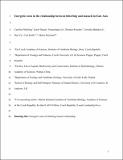Files in this item
Energetic costs in the coevolutionary relationship between bitterling fish and freshwater mussels
Item metadata
| dc.contributor.author | Methling, Caroline | |
| dc.contributor.author | Douda, Karel | |
| dc.contributor.author | Liu, Huanzhang | |
| dc.contributor.author | Rouchet, Romain | |
| dc.contributor.author | Bartáková, Veronika | |
| dc.contributor.author | Yu, Dan | |
| dc.contributor.author | Smith, Carl | |
| dc.contributor.author | Reichard, Martin | |
| dc.date.accessioned | 2019-11-07T00:36:35Z | |
| dc.date.available | 2019-11-07T00:36:35Z | |
| dc.date.issued | 2018-11-07 | |
| dc.identifier | 256160479 | |
| dc.identifier | 5bd8713a-da95-4140-9f19-2065c21a1c3b | |
| dc.identifier | 85064567479 | |
| dc.identifier | 000454039800007 | |
| dc.identifier.citation | Methling , C , Douda , K , Liu , H , Rouchet , R , Bartáková , V , Yu , D , Smith , C & Reichard , M 2018 , ' Energetic costs in the coevolutionary relationship between bitterling fish and freshwater mussels ' , Biological Journal of the Linnean Society , vol. Advance Articles . https://doi.org/10.1093/biolinnean/bly178 | en |
| dc.identifier.issn | 0024-4066 | |
| dc.identifier.other | ORCID: /0000-0003-3285-0379/work/50743671 | |
| dc.identifier.uri | https://hdl.handle.net/10023/18866 | |
| dc.description | This research was supported by the Czech Science Foundation (13-05872S) and the Strategic Priority Research Program of the Chinese Academy of Sciences (grant no. XDB31040000). | en |
| dc.description.abstract | Bitterling fishes and unionid mussels are involved in a two-sided co-evolutionary association. On the one side, bitterling exploit unionids by ovipositing in their gills. On the other side, unionids develop via a larval stage (glochidium) that attaches to fish gills. Both interactions are parasitic and expected to have negative consequences for the host. Here, we examine the effects of this association on the metabolic rates of mussel and fish hosts by measuring oxygen uptake rates (MO2). Measurements were performed on two widespread and broadly coexisting species, namely the rose bitterling Rhodeus ocellatus and Chinese pond mussel Sinanodonta woodiana. As predicted, we observed an increase in routine MO2 in mussels parasitized by bitterling, but only when hosting early stages of bitterling embryos that reside in the interlamellar space of the gills and obstruct water circulation. Hosting later-stage bitterling embryos (that reside in the suprabranchial cavity outside the host gills) was not associated with a higher routine MO2. We did not observe an acute negative effect of glochidial infestations on maximal oxygen uptake rate (MO2max), but glochidia-infested bitterling showed consistently lower oxygen consumption rates during recovery from MO2max. Our results suggest that acute costs of this mutually parasitic relationship might be mitigated, at least in part, by adaptations to limit infestation rates. | |
| dc.format.extent | 299397 | |
| dc.language.iso | eng | |
| dc.relation.ispartof | Biological Journal of the Linnean Society | en |
| dc.subject | Acheilognathinae | en |
| dc.subject | Branchial parasites | en |
| dc.subject | Evolutionary arms race | en |
| dc.subject | Metabolic rate | en |
| dc.subject | Unionidae | en |
| dc.subject | QH301 Biology | en |
| dc.subject | NDAS | en |
| dc.subject.lcc | QH301 | en |
| dc.title | Energetic costs in the coevolutionary relationship between bitterling fish and freshwater mussels | en |
| dc.type | Journal article | en |
| dc.contributor.institution | University of St Andrews. School of Biology | en |
| dc.identifier.doi | 10.1093/biolinnean/bly178 | |
| dc.description.status | Peer reviewed | en |
| dc.date.embargoedUntil | 2019-11-07 | |
| dc.identifier.url | https://academic.oup.com/biolinnean/advance-article/doi/10.1093/biolinnean/bly178/5164100?searchresult=1 | en |
This item appears in the following Collection(s)
Items in the St Andrews Research Repository are protected by copyright, with all rights reserved, unless otherwise indicated.

